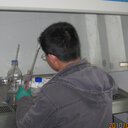Alleviation of podophyllotoxin toxicity using coexisting flavonoids from Dysosma versipellis.
Sleutelwoorden
Abstract
Podophyllotoxin (POD) is a lignan-type toxin existing in many herbs used in folk medicine. Until now, no effective strategy is available for the management of POD intoxication. This study aims to determine the protective effects of flavonoids (quercetin and kaempferol) on POD-induced toxicity. In Vero cells, both flavonoids protected POD-induced cytotoxicity by recovering alleviating G2/M arrest, decreasing ROS generation and changes of membrane potential, and recovering microtubule structure. In Swiss mice, the group given both POD and flavonoids group had significantly lower mortality rate and showed less damages in the liver and kidney than the group given POD alone. As compared to the POD group, the POD plus flavonoids group exhibited decreases in plasma transaminases, alkaline phosphatase, lactate dehydrogenase, plasma urea, creatinine and malondialdehyde levels, and increases in superoxide dismutase and glutathione levels. Histological examination of the liver and kidney showed less pathological changes in the treatment of POD plus flavonoids group. The protective mechanisms were due to the antioxidant activity of flavonoids against the oxidative stress induced by POD and the competitive binding of flavonoids against POD for the same colchicines-binding sites. The latter binding was confirmed by the tubulin assembly assay in combination with molecular docking analyses. In conclusion, this study for the first time demonstrated that the coexisting flavonoids have great protective effects against the POD toxicity, and results of this study highlighted the great potential of searching for effective antidotes against toxins based on the pharmacological clues.





